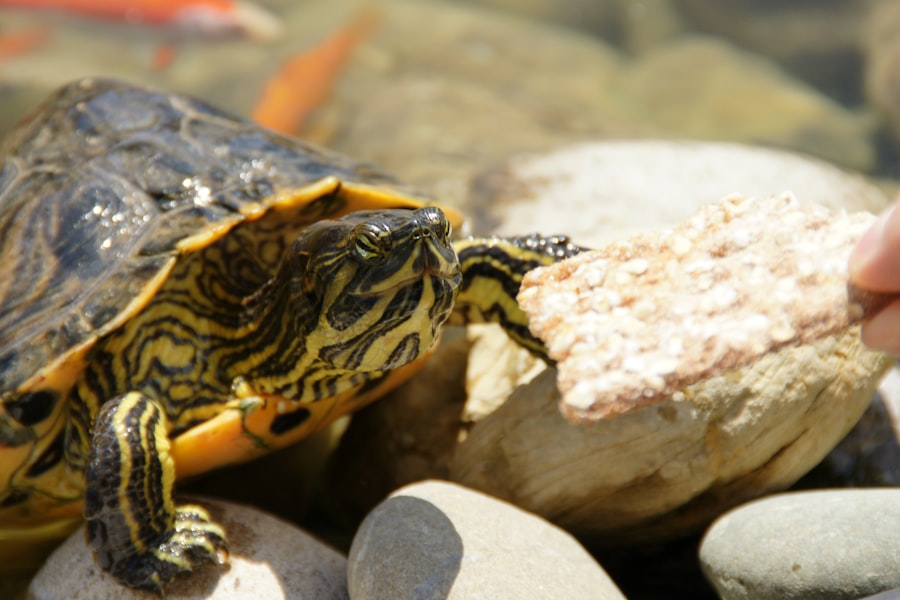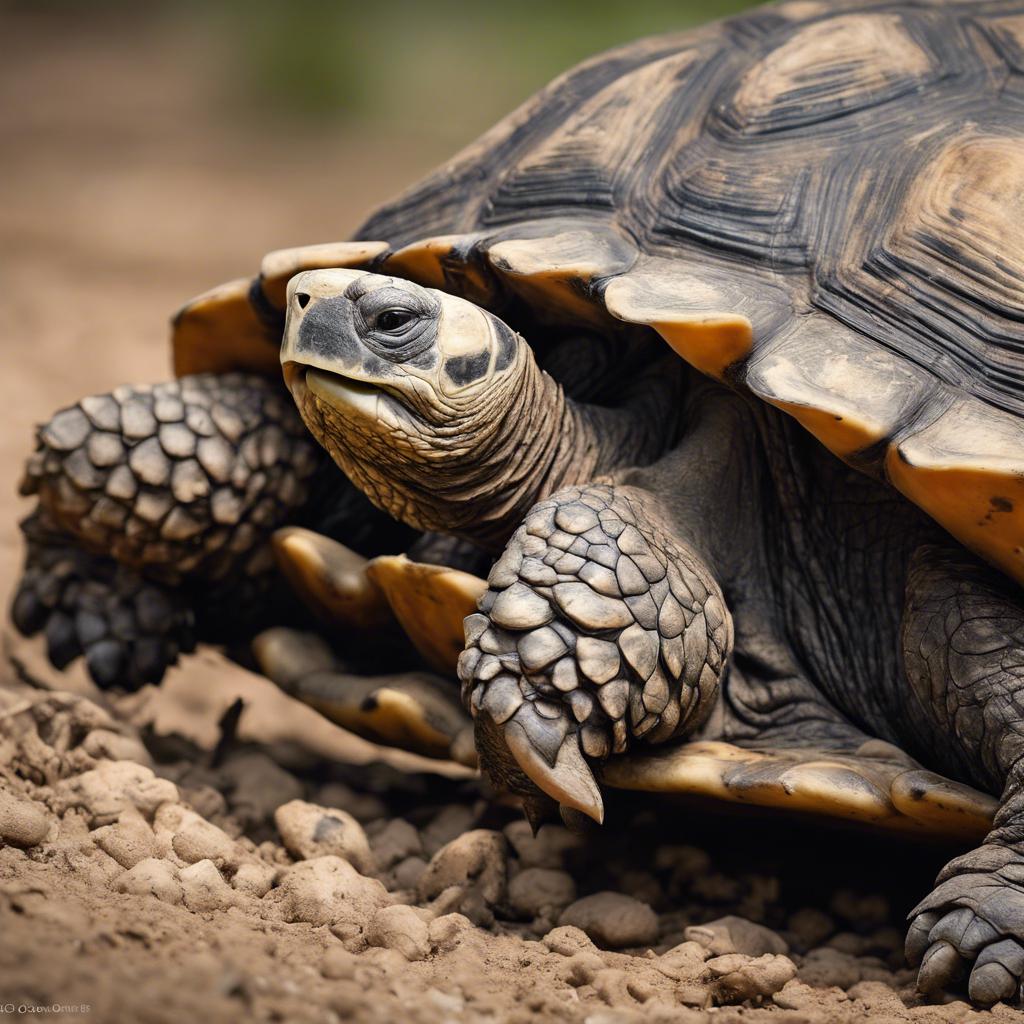Tortoises are fascinating creatures that belong to the reptile family. They are known for their hard shells and slow movements. Tortoises are herbivores, meaning they primarily eat plants and vegetation. Their diet consists of a variety of fruits, vegetables, and leafy greens. Different types of tortoises have different eating habits, depending on their natural habitat and the availability of food sources.
There are several species of tortoises, each with its own unique eating habits. For example, the African spurred tortoise is known to consume a wide range of plants, including grasses, succulents, and even cacti. The Russian tortoise, on the other hand, prefers a diet that consists mainly of leafy greens such as dandelion greens and kale. The Galapagos tortoise, which is one of the largest species of tortoises, primarily feeds on grasses and cacti.
Key Takeaways
- Tortoises are herbivores and have specific dietary needs.
- Food is crucial for the health and survival of tortoises.
- Factors such as age, species, and health can affect how long tortoises can go without eating.
- Tortoises can survive for several months without food, but prolonged starvation can have serious health consequences.
- Signs of hunger and malnutrition in tortoises include weight loss, lethargy, and changes in behavior.
The importance of food for tortoises
Food plays a crucial role in the growth and development of tortoises. Like all living organisms, tortoises require certain nutrients to survive and thrive. These nutrients include carbohydrates, proteins, fats, vitamins, and minerals. A balanced diet that provides these essential nutrients is necessary for the overall health and well-being of tortoises.
Carbohydrates are an important source of energy for tortoises. They provide the fuel needed for daily activities such as walking and foraging for food. Proteins are essential for muscle growth and repair, while fats provide insulation and help regulate body temperature. Vitamins and minerals are necessary for various bodily functions, including bone development, immune system function, and reproduction.
Factors affecting the duration of time tortoises can go without eating
The duration of time that a tortoise can go without eating depends on several factors. Age, size, and species of tortoise play a significant role in determining their food requirements and how long they can survive without eating. Young tortoises, for example, have higher energy needs and may need to eat more frequently than adult tortoises. Similarly, larger tortoises require more food to sustain their size and metabolism.
Environmental factors such as temperature and humidity also affect the duration of time tortoises can go without eating. Tortoises are ectothermic animals, which means they rely on external sources of heat to regulate their body temperature. In colder temperatures, their metabolism slows down, and they may not need to eat as frequently. However, extreme temperatures can also be detrimental to their health and may lead to starvation if food sources are scarce.
How long can tortoises survive without food?
Tortoises are known for their ability to survive long periods without food. In the wild, they have adapted to survive in environments where food may be scarce or seasonal. The maximum duration of time that a tortoise can go without food depends on various factors, including its age, size, species, and environmental conditions.
Generally, tortoises can survive for several weeks or even months without eating. However, prolonged starvation can have serious consequences for their health and well-being. Without a regular supply of nutrients, tortoises may experience weight loss, muscle wasting, and weakened immune systems. They become more susceptible to diseases and infections and may even suffer from organ failure if the starvation continues for an extended period.
Signs of hunger and malnutrition in tortoises
It is essential for tortoise owners to be aware of the signs of hunger and malnutrition in their pets. Physical signs such as weight loss, sunken eyes, and a dull shell are indicators that a tortoise is not getting enough food. Lethargy and decreased activity levels are also common signs of hunger and malnutrition.
Behavioral signs can also indicate that a tortoise is not eating enough. A lack of appetite, refusal to eat, or only eating small amounts are all signs that a tortoise may be experiencing hunger or malnutrition. Changes in behavior, such as increased aggression or irritability, can also be a result of inadequate nutrition.
The risks of prolonged starvation in tortoises

Prolonged starvation can have severe consequences for the health and well-being of tortoises. Without a regular supply of nutrients, their bodies begin to break down muscle tissue for energy, leading to weight loss and muscle wasting. This can weaken their immune systems and make them more susceptible to diseases and infections.
Starvation can also lead to organ failure in tortoises. The lack of essential nutrients can cause the organs to malfunction and eventually shut down. This can be life-threatening and may require immediate veterinary intervention.
Tips for feeding tortoises and maintaining a healthy diet
To ensure that your tortoise receives a balanced diet, it is important to provide a variety of foods that meet their nutritional requirements. Safe and nutritious foods for tortoises include leafy greens such as kale, dandelion greens, and collard greens. Fruits such as strawberries, melons, and apples can also be offered in moderation. It is important to avoid feeding them foods that are toxic or harmful to their health, such as onions, garlic, and avocado.
Feeding frequency and portion sizes should be determined based on the age, size, and species of your tortoise. Young tortoises may need to eat more frequently than adults, while larger tortoises require larger portion sizes. It is important not to overfeed or underfeed your tortoise, as both can have negative consequences for their health.
Common mistakes in feeding tortoises and how to avoid them
One common mistake in feeding tortoises is overfeeding. While it may be tempting to offer your tortoise large amounts of food, overfeeding can lead to obesity and other health problems. It is important to provide portion sizes that are appropriate for your tortoise's size and age.
Another mistake is feeding inappropriate foods. Some foods that are safe for humans or other animals may be toxic or harmful to tortoises. It is important to research and understand which foods are safe and nutritious for your tortoise. Avoid feeding them foods that are high in fat, sugar, or salt, as these can be detrimental to their health.
The role of hydration in the survival of tortoises
In addition to food, water is also essential for the survival of tortoises. Hydration is crucial for maintaining proper bodily functions and preventing dehydration. Tortoises obtain water from both their food and external sources such as water bowls or natural bodies of water.
Signs of dehydration in tortoises include sunken eyes, dry skin, and lethargy. To prevent dehydration, it is important to provide a shallow water dish that allows the tortoise to soak and drink as needed. The water should be changed regularly to ensure cleanliness and freshness.
Conclusion and summary of key takeaways
In conclusion, food plays a vital role in the growth and development of tortoises. A balanced diet that provides essential nutrients is necessary for their overall health and well-being. The duration of time that a tortoise can go without eating depends on various factors, including its age, size, species, and environmental conditions.
Prolonged starvation can have serious consequences for the health of tortoises, including weight loss, weakened immune systems, and organ failure. It is important for tortoise owners to be aware of the signs of hunger and malnutrition and take appropriate measures to address them.
Feeding tortoises a healthy diet and providing them with access to clean water is essential for their survival. It is important to avoid common mistakes such as overfeeding or feeding inappropriate foods. By following these guidelines, tortoise owners can ensure the health and well-being of their pets.
If you're curious about how long tortoises can go without eating, you might find this article from Reptile Wizard interesting. They provide valuable insights into the feeding habits and dietary needs of tortoises, helping you understand how to properly care for these fascinating creatures. To learn more, check out their article on Reptile Wizard.
FAQs
What is a tortoise?
A tortoise is a reptile that belongs to the family Testudinidae. They are known for their hard, protective shells and slow movements.
How long can tortoises go without eating?
The length of time a tortoise can go without eating depends on various factors such as age, species, and health. However, in general, tortoises can survive without food for several weeks to months.
Why do tortoises go without eating?
Tortoises may go without eating due to various reasons such as hibernation, illness, stress, or lack of appetite. It is important to identify the cause and address it accordingly to ensure the tortoise's health and well-being.
What happens if a tortoise goes without eating for too long?
If a tortoise goes without eating for too long, it can lead to various health problems such as weight loss, dehydration, and organ failure. In severe cases, it can even lead to death.
How can I tell if my tortoise is not eating?
Signs that your tortoise is not eating include a decrease in activity level, weight loss, sunken eyes, and lack of interest in food. It is important to monitor your tortoise's eating habits and seek veterinary care if you notice any concerning changes.

